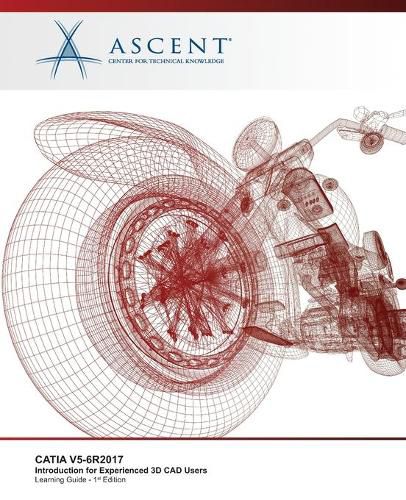Readings Newsletter
Become a Readings Member to make your shopping experience even easier.
Sign in or sign up for free!
You’re not far away from qualifying for FREE standard shipping within Australia
You’ve qualified for FREE standard shipping within Australia
The cart is loading…






The CATIA V5-6R2017: Introduction for Experienced 3D CAD Users learning guide is intended to provide accelerated introductory training in CATIA V5-6R2017 software. This learning guide is designed for users who have 3D modeling design experience with other 3D CAD software packages (e.g., Creo Parametric(TM), Inventor(TM), NX(TM), SolidWorks(R), etc.).
By leveraging the experience users gain in working with other 3D modeling software packages, this hands-on, practice-intensive guide is developed so that users who are new to CATIA can benefit from a shorter, introductory-level, learning guide. You are taught how to find and use the modeling tools associated with familiar modeling strategies that are used in other 3D CAD software. You will acquire the knowledge necessary to complete the process of creating models from conceptual sketching, through to solid modeling, assembly design, and drawing production.
This guide was developed against CATIA V5-6R2017, Service Pack 1.
Topics Covered
Customization of CATIA V5 Environment Creating and Constraining Sketch Geometry Sketched Feature Techniques and Formulas Adding Material with Pad and Shaft Features Thin Features, Stiffeners Removing Material with Pocket and Groove Features Rib and Slot Features Creating Reference Elements for construction and measurement Fillet, Chamfer, Hole, Draft, and Shell Dress-Up Features Pattern, Copy, and Mirror Duplication Features Obtaining Part Information Generative Drafting View Creation Generative Drafting Dimensioning and Annotation Multi-sections Solid Features Feature Management Using the Hide / Show, Activate / Deactivate Functions Parent/Child Relationships and Feature Failure Resolution Assembly Design Workbench Constraint creation, assembly management, and PDM considerations Obtaining Assembly Information (Measure, Clash, and Bill of Materials) Working with Multi-Body Models
Prerequisites
Experience in mechanical design and drawing production using 3D CAD software.
$9.00 standard shipping within Australia
FREE standard shipping within Australia for orders over $100.00
Express & International shipping calculated at checkout
The CATIA V5-6R2017: Introduction for Experienced 3D CAD Users learning guide is intended to provide accelerated introductory training in CATIA V5-6R2017 software. This learning guide is designed for users who have 3D modeling design experience with other 3D CAD software packages (e.g., Creo Parametric(TM), Inventor(TM), NX(TM), SolidWorks(R), etc.).
By leveraging the experience users gain in working with other 3D modeling software packages, this hands-on, practice-intensive guide is developed so that users who are new to CATIA can benefit from a shorter, introductory-level, learning guide. You are taught how to find and use the modeling tools associated with familiar modeling strategies that are used in other 3D CAD software. You will acquire the knowledge necessary to complete the process of creating models from conceptual sketching, through to solid modeling, assembly design, and drawing production.
This guide was developed against CATIA V5-6R2017, Service Pack 1.
Topics Covered
Customization of CATIA V5 Environment Creating and Constraining Sketch Geometry Sketched Feature Techniques and Formulas Adding Material with Pad and Shaft Features Thin Features, Stiffeners Removing Material with Pocket and Groove Features Rib and Slot Features Creating Reference Elements for construction and measurement Fillet, Chamfer, Hole, Draft, and Shell Dress-Up Features Pattern, Copy, and Mirror Duplication Features Obtaining Part Information Generative Drafting View Creation Generative Drafting Dimensioning and Annotation Multi-sections Solid Features Feature Management Using the Hide / Show, Activate / Deactivate Functions Parent/Child Relationships and Feature Failure Resolution Assembly Design Workbench Constraint creation, assembly management, and PDM considerations Obtaining Assembly Information (Measure, Clash, and Bill of Materials) Working with Multi-Body Models
Prerequisites
Experience in mechanical design and drawing production using 3D CAD software.